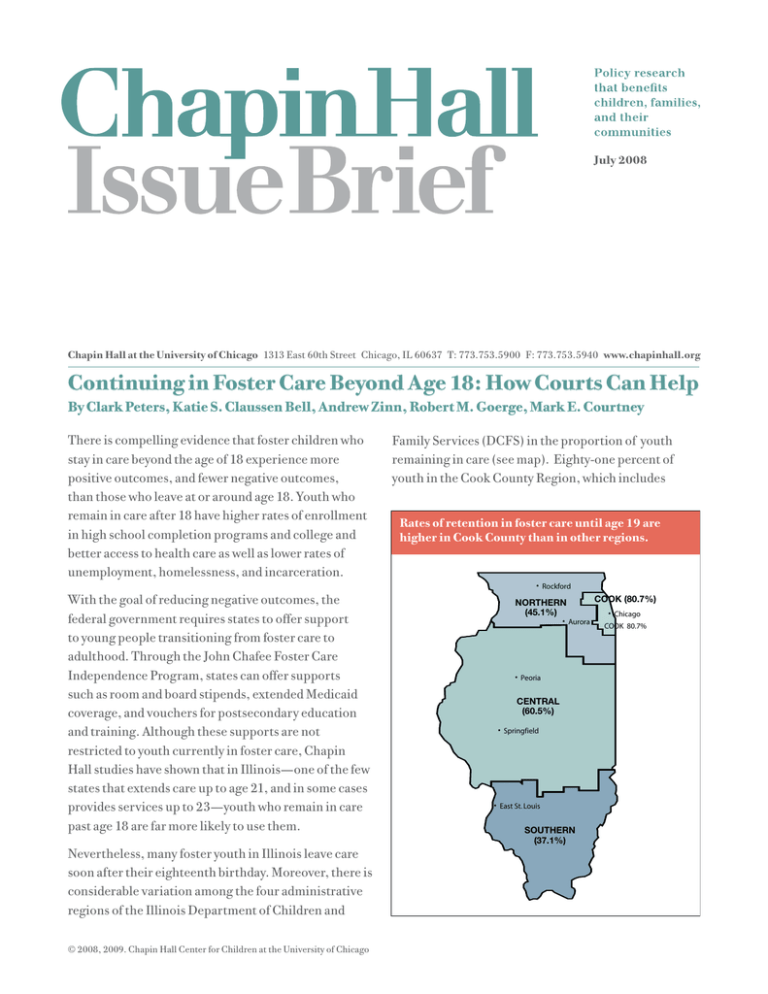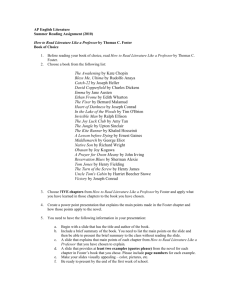Continuing in Foster Care Beyond Age 18: How Courts Can... By Clark Peters, Katie S. Claussen Bell, Andrew Zinn, Robert...
advertisement

July 2008 Chapin Hall at the University of Chicago 1313 East 60th Street Chicago, IL 60637 T: 773.753.5900 F: 773.753.5940 www.chapinhall.org Continuing in Foster Care Beyond Age 18: How Courts Can Help By Clark Peters, Katie S. Claussen Bell, Andrew Zinn, Robert M. Goerge, Mark E. Courtney There is compelling evidence that foster children who stay in care beyond the age of 18 experience more positive outcomes, and fewer negative outcomes, than those who leave at or around age 18. Youth who remain in care after 18 have higher rates of enrollment in high school completion programs and college and better access to health care as well as lower rates of unemployment, homelessness, and incarceration. With the goal of reducing negative outcomes, the federal government requires states to offer support to young people transitioning from foster care to adulthood. Through the John Chafee Foster Care Independence Program, states can offer supports such as room and board stipends, extended Medicaid coverage, and vouchers for postsecondary education and training. Although these supports are not restricted to youth currently in foster care, Chapin Hall studies have shown that in Illinois—one of the few states that extends care up to age 21, and in some cases provides services up to 23—youth who remain in care past age 18 are far more likely to use them. Nevertheless, many foster youth in Illinois leave care soon after their eighteenth birthday. Moreover, there is considerable variation among the four administrative regions of the Illinois Department of Children and © 2008, 2009. Chapin Hall Center for Children at the University of Chicago Family Services (DCFS) in the proportion of youth remaining in care (see map). Eighty-one percent of youth in the Cook County Region, which includes Rates of retention in foster care until age 19 are higher in Cook County than in other regions. • Rockford COOK (80.7%) NORTHERN (45.1%) • Chicago • Aurora COOK 80.7% • Peoria CENTRAL (60.5%) • Springfield • East St. Louis SOUTHERN (37.1%) Chicago, remain in care beyond 18; fewer than 54 percent do so in other counties (often referred to as “Downstate”). Given the evidence that foster youth who remain in care until at least age 19 have better outcomes, understanding why there are regional differences is important to addressing the disparity. Why Some Youth Leave Care and Others Do Not To explore this question and take a step toward raising the state’s overall retention rate, DCFS asked Chapin Hall to conduct a study of regional differences. The goal was to identify the major factors that influence whether young people remain in care beyond 18. In addition to analyzing administrative data, researchers conducted a statewide survey of caseworkers, held focus groups with both caregivers and youth, and made site visits to interview court personnel across the state. Findings indicate that active court advocacy on behalf of foster youth plays a primary role in keeping youth in care. In Illinois, courts supervise all cases of youth in foster care, so once court jurisdiction ends, state care and services irrevocably end as well. By keeping cases open, courts enable youth to continue to receive child welfare services. Court advocacy was also found to affect retention rates indirectly by exerting an influence on other factors that play a role in foster care decisions. In particular, a higher degree of court advocacy is associated with • greater awareness of the law that says that youth may remain in care beyond 18; • greater availability of placements and services for older foster youth; • more involvement by caseworkers and other adults; • more positive attitudes about remaining in care beyond 18. 2 Chapin Hall at the University of Chicago Perceptions Matter—Awareness and Understanding of the Available Options for Keeping Youth in Care Below is a summary of Illinois statutory law regarding foster care. Foster youth themselves may decide to leave care at 18, but they are not required to do so. Although the substance of the law is important, common understanding of the law is equally critical. However, the major figures in the child welfare system—caseworkers, caregivers, youth, and even court personnel—exhibited significant variation in their understanding of the law and DCFS policy. For example, some were unaware that care could legally continue beyond 18 or high school graduation. A number of professionals (especially in the Central and Southern Regions) felt that the nature of the law, and the state’s implementation of it, presented obstacles to keeping youth in care beyond 18 or 19. Likewise, there Important Age Milestones for Illinois Foster Youth Age 18 State’s legal age of majority. Youth provides own consent for medical care. Youth receives DCFS allowance directly. DCFS placements and services may continue. Age 19 Court must make finding that continued care is in youth’s best interest in order for jurisdiction to continue. DCFS placements and services may continue. Age 21 End of juvenile court jurisdiction. DCFS placements and services are no longer available. Educational aid may continue. Age 23 End of any residual educational assistance through DCFS. was no consistent awareness of the resources, such as independent living options, that are available, or potentially available, to encourage extending foster care. Availability of Placements and Other Services Caregivers and youth in focus groups agreed that caseworkers tended not to recommend keeping a youth in care if appropriate placements were seen as unavailable or too far away. They also felt that the scarcity of attractive placement and service options was at least partly responsible for youths’ reluctance to stay in care. Caseworkers in Cook County (the administrative region with the highest retention rate) felt more confident about the availability of placements, while caseworkers in the Southern Region (with the lowest retention rate) did not believe that placements were available. Moreover, alternatives such as independent and transitional living programs were evidently scarcer outside the Cook County Region. In addition to placements, young people in foster care remain eligible for such services as counseling, educational support, and other therapeutic services. Although educational aid seemed to be a strong incentive for remaining in care, caregivers and youth tended to hold the services offered by agencies in low regard. According to focus groups and interviews, services tended to be geared toward two groups: youth with chronic and severe difficulties, and high achievers who were bound for college. I didn’t wanna stay in care at first, but I saw how my plans for college and everything, how it could help me and benefit me. So, of course that’s why I’m still here. Without the lure of services that are seen as helpful, agencies miss an opportunity to engage youth and retain them in their placements. The Adult Connection: The Importance of Adult Involvement and Engagement Available opportunities and services can only influence youths’ decisions to remain in care if they know about them. In this, they are largely dependent on the adults in their lives. But the involvement of adults in the lives of foster youth has a much more important role than simply providing information. Evidence from our study indicates that having stable and supportive relationships with caring adults helps keep youth in care and promote positive outcomes. These adults may be caseworkers, foster parents, parents, other kin, or other professionals. Establishing and maintaining these relationships, however, can sometimes prove difficult for a number of reasons, including the high rate of caseworker turnover, behavioral problems faced by foster parents of older youth, and continuing but conflicted relationships between youth and the parents who saw them enter care. According to one person, I think they’re just spread out too much. I think they need more workers than what they got now. I mean, they got good workers, don’t get me wrong. They’re decent workers, but it’s just that you got ’em spread out. The caseworker survey provided evidence that a strong connection to a foster parent is associated with longer retention in care. Many court personnel also viewed foster homes as places where youth might acquire valuable independent living skills, even in the absence of local social services. But some foster parents expressed frustration about not being involved in post-care planning and about rules that prevent children from returning to live in their foster homes once care is over. Youth also expressed concern about the precariousness of their relationships with the adults in their lives. Continuing in Foster Care Beyond Age 18 3 Personally, I don’t think you are ever likely prepared to just be [on your own]. You’re going to have a bumpy road or something like that. There’s nothing to turn back on, unless you have the strong support of your family. I have some support and connection, but . . . I’m thinking about the other youth that don’t have that, you know. At 18 they’re emancipated and then what, who do they turn to, who do they have to talk to? Grown-Up or Not? Attitudes about Adulthood and Continuing Care Caseworkers, court personnel, and caregivers consistently named youth attitudes as a challenge to keeping them in care. At 18, youth are legally adults. Feeling frustrated by the restrictions of foster care, they may request to leave or become uncooperative. Faced by youth opposition—explicit or passive—some agency and court personnel move to end care. Moreover, our study found that ambivalence toward extending care was also shared by some adults. Some adults expressed concern that extending care might encourage dependency on state services and, in the case of defiant youth, reinforce negative behavior. These attitudes on the part of adults in turn made some youth feel pressured to leave care. Involvement in court provides one way for youth to feel more in control of decisions regarding their cases, but in fact their court participation is generally limited. Attending hearings can be logistically difficult for 18-year-olds, especially in rural areas. And, almost all respondents in the study agreed that when youth do attend court hearings, their role is modest. Youth tended to see the proceedings as bothersome and irrelevant. 4 Chapin Hall at the University of Chicago The Meaning and Importance of Court Advocacy Ultimately, the court decides whether a foster care case will be closed or kept open. According to statutory law, when a youth reaches 19, the court must make a finding that continued care is in the youth’s “best interest” in order for jurisdiction to continue. Careful consideration of what is in a youth’s best interest is an important way in which courts can keep a case open and provide the youth with options that could make a difference in his or her future. It is often an advocate that shapes the court’s consideration of these options. The guardian ad litem, a person appointed by the court to represent the interests of an individual in a specific case, often plays an important role in advocating for young people. The Illinois Juvenile Court Act requires that all youth in juvenile court be represented by guardians ad litem. Representation can vary in form across the state, but the guardians ad litem of Cook County were seen as particularly vigorous in opposing efforts to close cases. According to respondents in the study, guardians ad litem are the strongest influence on the county’s high rate of retention in care. Juvenile court judges can also be important advocates for youth in foster care—for example, in one large county in DCFS’s Central Region, a judge will not close the case of a youth desiring release from foster care at 18 until the youth can provide a realistic plan for the immediate future. Several youth do return with improved ideas, while others decide upon reflection to remain in care after all. The judge reports that “We’ve been able to hold on to a few more that way.” The Future of Advocacy What Agencies Can Do The Chapin Hall study concluded that strong court advocacy plays a primary role in retaining youth in care. Jurisdictions demonstrating high levels of court advocacy on behalf of foster youth—such as Cook County and a few other counties with an urban center— exhibit the highest rates of retention in care. Our findings suggest that there are several points of leverage that public child welfare agencies can use in conjunction with courts to increase retention in foster care. Court Advocacy Awareness of Law/Policy Adult Involvement Resource Availability Attitudes re: Care > 18 Adult Involvement Court advocacy seems to support retaining youth in foster care in two ways. First, it does so directly, by keeping cases open, even in the face of obstacles, including resistance by youth, caseworkers, and others involved. Second, active court advocacy affects rates of retention indirectly, by influencing the four other factors found by researchers to affect when youth leave foster care. This dual influence of court advocacy is illustrated in the graphic above. Commitment by courts to keeping cases open reverberates through the system, influencing the availability of services and the awareness and attitudes of the people involved. Child welfare agencies might consider collaboration with juvenile courts or legal administrative bodies to provide additional resources and training to court personnel. DCFS and other child welfare agencies might also consider independent efforts to avoid the quick closure of cases and attend to other factors related to retention in care, such as awareness of statutory law, service and placement resources, and the involvement of adults. Efforts to change the attitudes of youth toward remaining in care also deserve attention. Such efforts could include providing more opportunities for youth to express their opinions and to influence the types of placements and services they receive. As a final point of leverage, child welfare agencies and the courts might consider changes to local court rules or statutory law to allow youth to return to care temporarily in times of crisis. After having spent several years in care, youth are sometimes unprepared to deal with the challenges of adulthood; however, once state jurisdiction has officially ended, they may have no source of support. Given the possible outcomes of homelessness or criminal activity, allowing for reentry into foster care even in a limited way could be beneficial for both society and the individual youth. Continuing in Foster Care Beyond Age 18 5 Established in 1985, Chapin Hall is an independent policy research center whose mission is to build knowledge that improves policies and programs for children and youth, families, and their communities. Chapin Hall’s areas of research include child maltreatment prevention, child welfare systems and foster care, youth justice, schools and their connections with social services and community organizations, early childhood initiatives, community change initiatives, workforce development, out-of-school time initiatives, economic supports for families, and child well-being indicators. Recommended Citation Acknowledgments Related Publications Contact Peters, C., Claussen Bell, K. S., Zinn, A., Goerge, R. M., & Courtney, M. E. (2008). Continuing in Foster Care Beyond Age 18: How Courts Can Help. Chicago: Chapin Hall at the University of Chicago This report was made possible through the support of the Illinois Department of Children and Family Services. Courtney, M. E., Dworsky, A., Cusick, G. R., Havlicek, J., Perez, A., & Keller, T. (2007). Midwest Evaluation of the Adult Functioning of Former Foster Youth: Outcomes at Age 21. Chicago: Chapin Hall at the University of Chicago. Chapin Hall at the University of Chicago 1313 East 60th Street Chicago, IL 60637 T: 773.753.5900 F: 773.753.5940 www.chapinhall.org Samuels, G. M. (2008). A Reason, a Season, or a Lifetime: Relational Permanence Among Young Adults with Foster Care Backgrounds. Chicago: Chapin Hall Center for Children at the University of Chicago. Cusick, G. R. & Courtney, M. E. (2007). Offending During Late Adolescence: How Do Youth Aging Out of Care Compare with Their Peers? Chicago: Chapin Hall at the University of Chicago. For a complete list of Chapin Hall projects and to download publications, please visit our website.





